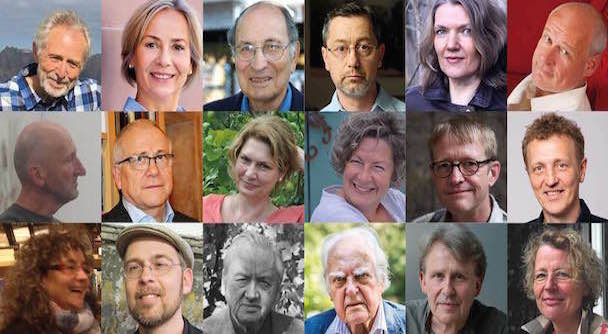Authors & Books
Ernst Kretschmer
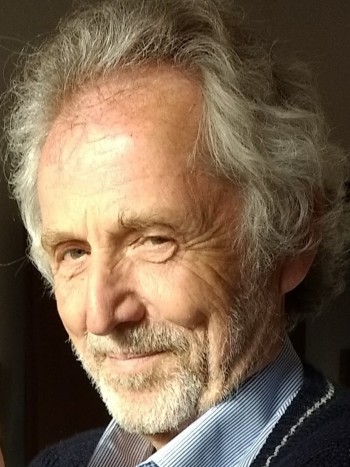
Ernst Kretschmer was born in 1951, he studied German language and literary studies, history, philosophy, comparative literature in Cologne, Cean and Bonn.
He is copublisher of the Morgenstern editions in Suttgart. For his research about Morgenstern and about nonsense he got the Kassel literature award for grotesque humour in 1990.
After lectureships at different unicersities in mailand, Pavia and Bergamo, is Ernst Kretschmer since 2005 professor for linguistics at the University of Modena/Reggio Emila, Italy. »LKW« is the debut novel of Ernst Kretschmer.

Spiegelschriften (Mirror Writings—Tales and Reports from Lake Maggiore)
- 2 volumes in slipcase
- Hardcovers
- with ribbon marker
- 400 pages and 408 pages
- with rich accompanying material
978-3-86638-390-6

The storyteller and German scholar Kretschmer has compiled two highly entertaining volumes and provided them with commentary and introductory texts—combining two of his passions and areas of expertise:
He has compiled a collection of 50 literary texts that were written on Lake Maggiore or are set here—even if two or three of their creators were on the lake in their vivid imaginations.—Ernst Kretschmer accompanies his discoveries around the Swiss and Italian shores with light-hearted yet background-rich essays on his 22 Italian and 28 Swiss finds.
He thus offers an extraordinary travel guide to the Long Lake region and, as a travel companion, opens up the history, culture, personalities and living environment around Lake Maggiore. The poets and storytellers in the two volumes come from a wide variety of countries, from the Frenchmen Hippolyte Taine and Stendhal, the American Ernest Hemingway, the Swede Lars Gustafsson, the Swiss Johanna Spyri, the Italians Dario Fo and Piero Chiara to numerous German authors such as Heinrich von Kleist, Erich Kästner, Gerhart Hauptmann and Jean Paul. The »Mirror Writings« thus also reflect the worldwide appeal of the lake and the region's diverse inspirations, which have had an unbroken appeal from the 18th century to the present day—both as a destination and as reading material.
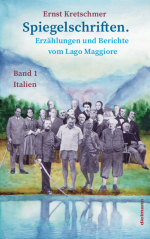
Spiegelschriften 1 (Mirror Writings, Volume 1)
Italy
- Hardcover
- 408 pages
- with ribbon marker
- with numerous author portraits
- and extensive appendices
978-3-86638-392-0

The Italy volume of Ernst Kretschmer's two »Spiegelschriften« is our volume 1, simply because Ernst Kretschmer has been living in this volume for many years: in Musignano, a few hundred metres above Maccagno on the Italian, or more precisely, the Lombardy part of the Sess.
The authors he has tracked down as veritable Lago Maggiore connoisseurs and neighbours are Lars Gustafsson, Kurt Tucholsky, Otto Zoller, Mario Soldati, Theodor Wolff, Johanna Spyri, Antonio Fogazzaro, Uffo Horn, Johann Wolfgang von Goethe, Jean Paul, Ernest Hemingway, Gerhart Hauptmann, Theodor Fontane, Hans Jakob Faesch, Hippolyte Taine, Stendhal, Dario Fo, Piero Chiara, Alois Emanuel Biedermann and Jacob Burckhard, Johann Heinrich Meyer and one of the most marvellous storytellers: himself!
He captured these fine places, which are always worth a visit, and put them on the literary map with his stories: Osogna, Bellinzona, Magadino, Maccagno, Locarno, Luino, Maccagno, Zenna, Castelli di Cannero, Porto Valtravaglia, Isola Bella, as outliers for good reason Varese and Milan, Laveno, Isola Bella and Isola Madre, Arona, Stresa, Brissago, Cavandone, Suna, Pallanza, Intra, Cannobio and Piaggio Valmara.
HERE is the table of contents (German Version) for the Italy volume in detail.
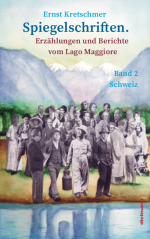
Spiegelschriften 1 (Mirror Writings, Volume 2)
Swiss
- Hardcover
- 400 pages
- with ribbon marker
- with numerous author portraits
- and extensive appendices
978-3-86638-391-3

The Switzerland volume of Ernst Kretschmer's two »Spiegelschriften« is dedicated to the smaller »half« of the Long Lake, the Ticino bend around Locarno and Ascona, including the famous Monte Veritá with its illustrious guests and events.
The places: Locarno is visited, described and narrated several times, often also Ascona, the enchanting Cannobio on the Italian side, Muralto, Minusio, Tenero, Margoscia, St Bartolomeo on the border, Bellinzona, the Verzasca Valley and Valle Maggia, Magadino, Comologno, Berzona, Sonlerto, Fontana Martina, Porto Ronco, Brissago and the islands of Brissago as well as the Isola grande.
The authors of these journeys are Erich Kästner, Liane Dirks, Erich Maria Remarque, Franz Hohler, Erich Mühsam, Hermann Hesse, Franziska zu Reventlow, Werner von der Schulenburg, Hans Morgenthaler, Friedrich Glauser, Ursula von Wiese and Werner Johannes Guggenheim, Emil Ludwig, Käthe Kruse, José Orabuena, Claire Goll, Aline Valangin, Max Frisch, Plinio Martini, Friederike Brun, Heinrich von Kleist, Oskar Maria Graf, Lisa Tetzner and Kurt Kläber, Giovanni Bonalumi, Ricarda Huch, Karl Viktor von Bonstetten and Hans Rudolf Schinz.
We would like to thank Lukas Bugla for the beautiful cover designs and his friendly encounters with literary figures.
HERE is the table of contents (German Version) for the Swiss volume in detail.
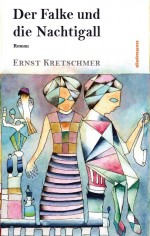
Der Falke und die Nachtigall (The Falcon And The Nightingale)
Novel
- Hardcover
- With dust jacket
- and Ribbon
- 280 pages
- Cover painting Lukas Bugla
- With extracts on Youtube
978-3-86638-251-0

A dubious Nazi squad is on the move in Palermo, the brown henchmen are to loot the tomb of Frederick II in the cathedral. One, who knows a lot about the life and death of the Staufer emperor, has been blackmailed into supporting the cultural theft—his sweetheart is interned in Ravensbrück and will only be released from the concentration camp if the grave treasure is kidnapped. While the unfree companion of the glommy expedition tries to rescue his beloved from brown Germany, the story of another lover blows at him, which can be as little true as his own experiences and tribulations: it is the story of a hunter and falconer from the time of the Staufer emperor, who wants to free his lady from the clutches of a powerful intringue.
»And what is to happen next?« you ask me. The answer to this can only be incomplete for the time being and yet also contains certainties that give reason for confidence: You will leave for Switzerland, dearest, for Lucerne, to be exact, where you will be safe from them. They shall then immediately get their orphan, who, be it said, is here in Palermo. I will explain everything else later. Do not worry. I know it: the mouse must meet the snake only with wisdom.
With his debut »LKW« (»Van«) in 2010, Ernst Kretschmer succeeded in writing a fabulously novel rich in characters. Its arabesque side stories and astonishing narrative whirlpools also characterize his new book, which contrasts the angels of death of the 1940s with those of the 13th century with great lovers.
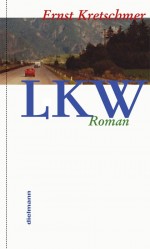
LKW
novel
- 488 pages
- Series Label (Reihe ETIKETT)
- Hardcover with ribbon pagemarker
978-3-86638-153-7

The novel »LKW« tells the story of a young men called Karl Krüger, who has worked for many years as a truck driver for building companies, furnitures and unit load transport between Germany, France and Italy. Through his work he has experienced a lot, has aged and matured and now he is going on his last drive to Mailand. Because he has fallen in love with an italian women... On this drive Karl recalls awild, but also poetic, rich life on the streets and passes of Europ An arc of suspence evolves perticularly after he has realised: there is a frontpassager, who calls himselfe »Kiepenkerl«and whos feed have a striking reseamblens to goats feet, like mephistopheles. In Karl’s childhood he signified disaster in his life, but now he offers him advise and help to arrange his momories: while the villages duck into the basins, the lights move together and send smoke signals in the sky, the Kiepenkerl conveys the driver Karl a manifestation: »In the mind of the driver«, he says: «interlock beginning and ending. In departing he always forshadows his arrival and hence calls the time at his side...the time... is a delightful creature. Empathetic and cuddly, she is prepared to devote herself. She wants yet to be charmed and flattered, otherwise she turns cold.«
Parallel to the lovestory the extent of the narration unfold the big drive into a european Tournee and back to a barbarian migration. Revenants of the maincharacter pulled through by the southern nobility and northern working traditions , it develops into a drive back into the lovestory, as old as the continent. The quest with pannier and fruit transporter, from the five year old to the fifty year old driver, also visits, through memories, the USA, conjures with the epics of America a desire for a modern Edda – and spins their entry.






